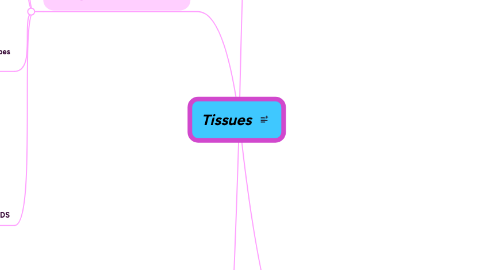
1. Epithelial Tissue
1.1. This protects the body and may also be a secretory and absorbent
1.2. It covers the surface of the body and the organs, cavities and tubes within it
1.2.1. SIMPLE EPITHELIUM - one cell thick
1.2.1.1. New node
1.2.1.1.1. SIMPLE CUBOIDAL EPITHELIUM - one cell thick, cuboid shaped. it lines glands and their ducts. it has absorptive or secretory function. e.g. lines the renal tubes
1.2.1.1.2. SIMPLE SQUAMOUS EPITHELIUM - flattened cells and one layer thick. thin and delicate so found in areas where the surface has to be easily permeable e.g. blood vessels and alveoli
1.2.1.1.3. SIMPLE COLUMNAR EPITHELIUM - lines organs that have absorptive/secretory function e.g. small and large intestines, digestive glands
1.2.1.1.4. CILIATED EPITHELIUM - has tiny hair like projections (cilia) and their function is to waft particles along the surface and out the body. these are found in the upper resp tract and uterine tubes (to move fertilised egg along)
1.2.2. STRATIFIED/COMPOUND EPITHELIUM - more than one layer thick
1.2.2.1. STRATIFIED EPITHELIUM - tough and thick. in areas that have wear and tear e.g. epidermis of skin
1.2.2.2. TRANSITIONAL EPITHELIUM - specialised to the urinary system e.g bladder and uterus. are capable of stretching
1.3. There are three basic types of epithelial cell;
1.3.1. squamous cells - flattened in shape
1.3.2. cuboidal cells - square or cube shaped
1.3.3. columnar cells - column shaped (height is greater than the width)
1.4. GLANDS
1.4.1. UNICELLULAR GLANDS - have individual secretory cells (goblet cell which secretes clear sticky mucus) the epithelium is called MUCOUS MEMBRANES, which traps particles, giving extra protection e.g. covers oral cavity, vagina and trachea
1.4.2. MULTICELLULAR GLANDS - have lots of secretory cells to form complex glands see fig 1.0
1.4.3. GLANDS CAN BE CATAGORISED;
1.4.3.1. EXOCRINE GLANDS - have a system of ducts where the products are taken directly to site they will be used
1.4.3.2. ENDOCRINE GLANDS - do not have a duct system and their secretions (hormones) are carried by blood to organ
2. Muscle tissue
2.1. SKELETAL/STRIATED MUSCLE
2.1.1. attached to skeleton and brings about movement. under voluntary control. each muscle fibre is made up of myofibrils made up of two proteins actin and myosin. the whole muscle is surrounded by the muscle sheath which continues with the tendons that connect muscle to bone
2.2. SMOOTH MUSCLE
2.2.1. unstriated/involuntary/visceral muscle. found in the walls of blood vessels, digestive tract, resp tract, bladder & uterus. responsible for all unconscious processes in the body. it is controlled by the autonomic nervous system
2.3. CARDIAC MUSCLE
2.3.1. only found in the HEART. responsible for the heart contraction and is involuntary. the muscle cells branch to create a network of fibres (linked by intercalated discs) which enable nerve impulses to be carried very quickly
3. Connective Tissue
3.1. responsible for supporting and holding organs and tissues in place.
3.2. THERE ARE MANY TYPES OF CONNECTIVE TISSUE;
3.2.1. BLOOD
3.2.1.1. circulates through blood vessels, and carries nutrients and oxygen to cells. contains the plasma
3.2.2. HAEMOPOIETIC TISSUE
3.2.2.1. jelly like connective tissue forms in the bone marrow within long bones and responsible for formation of blood cells
3.2.3. AREOLAR TISSUE/LOOSE CONNECTIVE TISSUE
3.2.3.1. tissue containing loose spaces is the most common connetcive tissue, found beneath skin, around blood vessels and nerves etc. contains collagen fibres with high tensile strength and elastic fibres which allows it to stretch. macrophages also present-
3.2.4. ADIPOSE TISSUE
3.2.4.1. similar to areolar tissue but its matrix contains mainly fat cells. fat cells act as an energy reserve , reduces heat loss e.g. kidney (provides protective layer)
3.2.5. FIBROUS/DENSE CONNECTIVE TISSUE
3.2.5.1. densely packed collagen fibres arrange in two different ways; parallel arrangment (tendons, ligaments) and irregularly interwoven fibres (found in the dermis of the skin and organs such as testes and lymph nodes)
3.2.6. CARTILAGE
3.2.6.1. rigid but flexible and can bear weight. compsed of shondrocytes. has no blood supply and nutrition is supplied by fibrous sheath (perichondrium) that surrounds it. THERE ARE THREE TYPES;
3.2.6.1.1. HYALINE CARTILAGE - most common type and forms articular surfaces of joints and provides support in the nose, larynx, trachea and bronchi. also forms skeleton of the embryo before ossification
3.2.6.1.2. ELASTIC CARTILAGE - has chondrocytes within matrix and elastic fibres. found in places where support with flexibility is needed e.g. external ear and epiglottis.
3.2.6.1.3. FIBROCARTILAGE - similar basic structure but more collagen fibres giving it strength e.g. intervertebral discs and menisci of stifle. also attaches tendons and ligements to bone
3.2.7. BONE
3.2.7.1. provides rigid supportive framework of the body and levers locomotion. THERE ARE TWO TYPES OF BONE TISSUE;
3.2.7.1.1. COMPACT BONE - solid, hard and found in the outer layer of all types of bone. haversian systems of compact bone are densley packed together
3.2.7.1.2. CANCELLOUS (SPONGY) BONE - consist of bony struts (trabeculae) in the bone marrow. found in the ends of long bones and the core of short, irregular and flat bones
3.2.7.2. calcification gives bone its rigidity and hardness.
